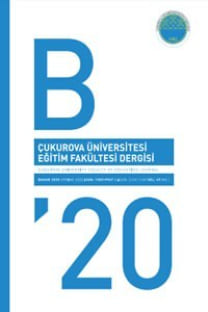Adaptation of the Energy Literacy Scale into Turkish: A Validity and Reliability Study*
Adaptation of the Energy Literacy Scale into Turkish: A Validity and Reliability Study*
___
- Akitsu, Y.,Ishihara, K. N., Okumura, H., &Yamasue, E. (2017). Investigatingenergyliteracyanditsstructural model forlowersecondarystudents in Japan.International Journal of EnvironmentalandScienceEducation,12(5), 1067-1095.
- Ajzen, I. &Fishbein, M. (1980). Understandingattitudesandpredictingsocialbehavior.EnglewoodCliffs, NJ: Prentice-Hall.
- Armaroli, N. &Balzani, V. (2007). Thefuture of energysupply: challengesandopportunities. AngewandteChemie International Edition, 46 (1–2), 52–66.
- Barrow, L. H. &Morrisey, J. T. (1989). Energyliteracy of ninth-gradestudents: A comparisonbetween Maine and New Brunswick. Journal of EnvironmentalEducation, 20(2), 22-25.
- Bodzin, A. (2012). Investigating urban eight-gradestudents’ knowledge of energyresources. International Journal of ScienceEducation, 34(8), 1255-1275.
- Bodzin, A.M., Fu, Q., Peffer, T.E., &Kulo, V. (2013). Developingenergyliteracy in US middle-levelstudentsusingthegeospatialcurriculumapproach.International Journal of ScienceEducation,35(9), 1561-1589.
- Boylan, C. (2008). Exploringelementarystudents’ understanding of energyandclimatechange.International Electronic Journal of ElementaryEducation,1(1), 1-15.
- Brounen, D., Kok, N., &Quigley, J.M. (2013). Energyliteracy, awareness, andconservationbehavior of residentialhouseholds.EnergyEconomics,38, 42-50.
- Chen, K.L.,Liu,S.Y., &Chen, P.H. (2015). Assessingmultidimensionalenergyliteracy of secondarystudentsusingcontextualizedassessment.International Journal of EnvironmentalandScienceEducation,10(2), 201-218.
- Chen, S.J.,Chou, Y.C., Yen, H.Y., &Chao, Y.L. (2015). Investigatingandstructuralmodelingenergyliteracy of highschoolstudents in Taiwan.EnergyEfficiency,8(4), 791-808.
- Chikaire, J.U., Ani, A.O., Nnadi, F.N., &Godson-Ibeji, C.C. (2015). Energyextensionandenergyliteracyforsustainableenergydevelopment in ruralNigeria.AgriculturalAdvances,4(8), 84-92.
- Cotton, D.R.E., Miller, W., Winter, J., Bailey, I., &Sterling, S. (2015). Developingstudents’ energyliteracy in highereducation.International Journal of Sustainability in HigherEducation,16(4), 456-473.
- DeWaters, J. E. &Powers, S. E. (2011). Energyliteracy of secondarystudents in New York State (USA): A measure of knowledge, affect, andbehavior.Energypolicy,39(3), 1699-1710.
- DeWaters, J. & Powers, S. (2013). Establishingmeasurementcriteriafor an energyliteracyquestionnaire.TheJournal of EnvironmentalEducation,44(1), 38-55.
- DeWaters, J.,Qaqish, B., Graham, M., & Powers, S. (2013). Designing an energyliteracyquestionnaireformiddleandhighschoolyouth. Journal of Environment Education, 44(1), 56–78.
- Fah, L.Y.,Hoon, K.C., Munting, E.T., &Chong, C.A. (2012). Secondaryschoolstudents' energyliteracy: Effect of genderandschoollocation.OIDA International Journal of Sustainable Development,3(7), 75-86.
- Göcük, A. & Şahin, F. (2016). Theeffect of problem basedlearning on 5thgradesstudents’ energyliteracy.Journal of Human Sciences,13(2), 3446-3468.
- Güven, G. & Sülün, Y. (2017). Pre-service teachers' knowledgeandawarenessaboutrenewableenergy.RenewableandSustainableEnergyReviews,80, 663-668.
- Hırça, N., Çalık, M., & Akdeniz, F. (2008). Investigatinggrade 8 students’ conceptions of energyandrelatedconcepts. Journal of TurkishScienceEducation, 5(1), 75-85.
- Horst, D., Harrison, C., Staddon, S., &Wood, G. (2016). Improvingenergyliteracythroughstudent-ledfieldwork–at home.Journal of Geography in HigherEducation,40(1), 67-76.
- Jin, H. &Anderson, C. W. (2012). A learningprogressionforenergy in socio-ecologicalsystems. Journal of Research in ScienceTeaching, 49(9), 1149-1180.
- Karpudewan, M.,Ponniah, J., &Zain, A.N.M. (2016). Project-basedlearning: An approachtopromoteenergyliteracyamongsecondaryschoolstudents.TheAsia-Pacific EducationResearcher,25(2), 229-237.
- Lay, Y. F.,Khoo, C. H., Treagust, D. F., &Chandrasegaran, A. L. (2013). Assessingsecondaryschoolstudents' understanding of therelevance of energy in theirdailylives.International Journal of EnvironmentalandScienceEducation,8(1), 199-215.
- Lee, L.S.,Chang, L.T., Lai, C.C., Guu, Y.H., & Lin, K.Y. (2015). Energyliteracy of vocationalstudents in Taiwan.EnvironmentalEducationResearch,23(6), 855-873.
- Lee, H.S. &Liu, O.L. (2010). Assessinglearningprogression of energyconceptsacrossmiddleschoolgrades: Theknowledgeintegrationperspective.ScienceEducation, 94(4), 665-688.
- Lee, L.S., Lee, Y.F., Altschuld, J.W., &Pan, Y.J. (2015). Energyliteracy: Evaluatingknowledge, affect, andbehavior of students in Taiwan.EnergyPolicy,76, 98-106.
- Liu, X. &Tang, L. (2004). Theprogression of students’ conceptions of energy: A cross-grade, cross-culturalstudy. CanadianJournal of Science, MathematicsandTechnologyEducation, 4(1), 43-57.
- Opitz, S. T.,Harms, U., Neumann, K., Kowalzik, K., & Frank, A. (2015). Students’ energyconcepts at thetransitionbetweenprimaryandsecondaryschool.Research in ScienceEducation, 45(5), 691-715.
- Panwar, N. L.,Kaushik, S. C., &Kothari, S. (2011). Role of renewableenergysources in environmentalprotection: A review. RenewableandSustainableEnergyReviews, 15(3), 1513-1524.
- Rizaki, A. &Kokkotas, P. (2013). Theuse of historyandphilosophy of science as a corefor a socioconstructivistteachingapproach of theconcept of energy in primaryeducation. Science&Education, 22(5), 1141-1165.
- Schermelleh-Engel, K.,Moosbrugger, H., &Müler, H. (2003). Evaluatingthe fit of structuralequationmodels: Tests of significanceanddescriptivegoodness-of-fit measures. Methods of PsychologicalResearch Online, (8)2, 23-74.
- Seçer, İ. (2013). SPSS ve Lisrel ile pratik veri analizi. Ankara: Anı Yayıncılık.
- Sovacool, B.K. &Blyth, P.L. (2015). Energyandenvironmentalattitudes in thegreenstate of Denmark: implicationsforenergydemocracy, lowcarbontransitions, andenergyliteracy.EnvironmentalScience&Policy,54, 304-315.
- Tavşancıl, E. (2006). Tutumların ölçülmesi ve SPSS ile veri Analizi (3. Baskı). Ankara: Nobel Yayınları.
- Töman, U. & Odabaşı-Çimer, S. (2013). An investigationintotheconceptionenergyconservation at differenteducationallevels.Journal of EducationalandInstructionalStudies in the World, 3(1), 44-52.
- Ünal-Çoban, G.,Aktamış, H., & Ergin, Ö. (2007). İlköğretim 8. sınıf öğrencilerinin enerjiyle ilgili görüşleri. Kastamonu Eğitim Dergisi, 15(1), 175-184.
- Yürümezoğlu, K., Ayaz, S., &Çökelez, A. (2009). Grade 7-9 students’ perceptions of energyandrelatedconcepts. NecatibeyFaculty of Education Electronic Journal of ScienceandMathematicsEducation,3(2), 52-73.
- ISSN: 1302-9967
- Yayın Aralığı: 3
- Başlangıç: 2000
- Yayıncı: Çukurova Üniversitesi Matbaası
Avni YILDIZ, Serdal BALTACI, Cahit AYTEKİN
Pedagojik Formasyon Sertifika Programı Öğrencilerinin Eğitim İnançlarının İncelenmesi
Demet SEVER, Dilruba KÜRÜM YAPICIOĞLU, Derya ATİK KARA
Lise Öğrencilerinin Biyoloji Öğrenmeye Yönelik Motivasyonları
Evlilik Anlamına İlişkin Metaforik Bir İnceleme
Nilüfer ÖZABACI, Serdar KÖRÜK, Ahmet KARA
İkinci Kariyer Öğretmenleri: Kariyer Değiştirme Nedenleri ve Uyum Durumları
